FORD FIESTA 2007 Owner's Manual
Manufacturer: FORD, Model Year: 2007, Model line: FIESTA, Model: FORD FIESTA 2007Pages: 1226, PDF Size: 61.26 MB
Page 21 of 1226

100-00-5 General Information 100-00-5
DESCRIPTION AND OPERATION
Component Tests
' A component test is used when a component is
tested in multiple pinpoint tests, or if a procedure
is too complicated to be formatted within a single
page of the pinpoint test.
Graphics
Test graphics show the measurement or test to be
performed in a test step.
A representative tester graphic is used for
voltmeters and ohmmeters.
If multiple measurements are made in a single
graphic, the test leads are drawn with a solid line
until the test lead splits to indicate the multiple
measurements, at which point dashed lines are
used.
Breakout box-type testers are represented by a
double circle test pin. Test pins are labeled with
the pin number.
Special Tools and Torque Figures
Any requirement for special tools will picture the
tool, showing it in use and with its tool number
( ' shown. Torque settings will be given at the relevant
point in the procedure.
2006.0 Fiesta 1212006 GI 7371 en
procarmanuals.com
Page 22 of 1226
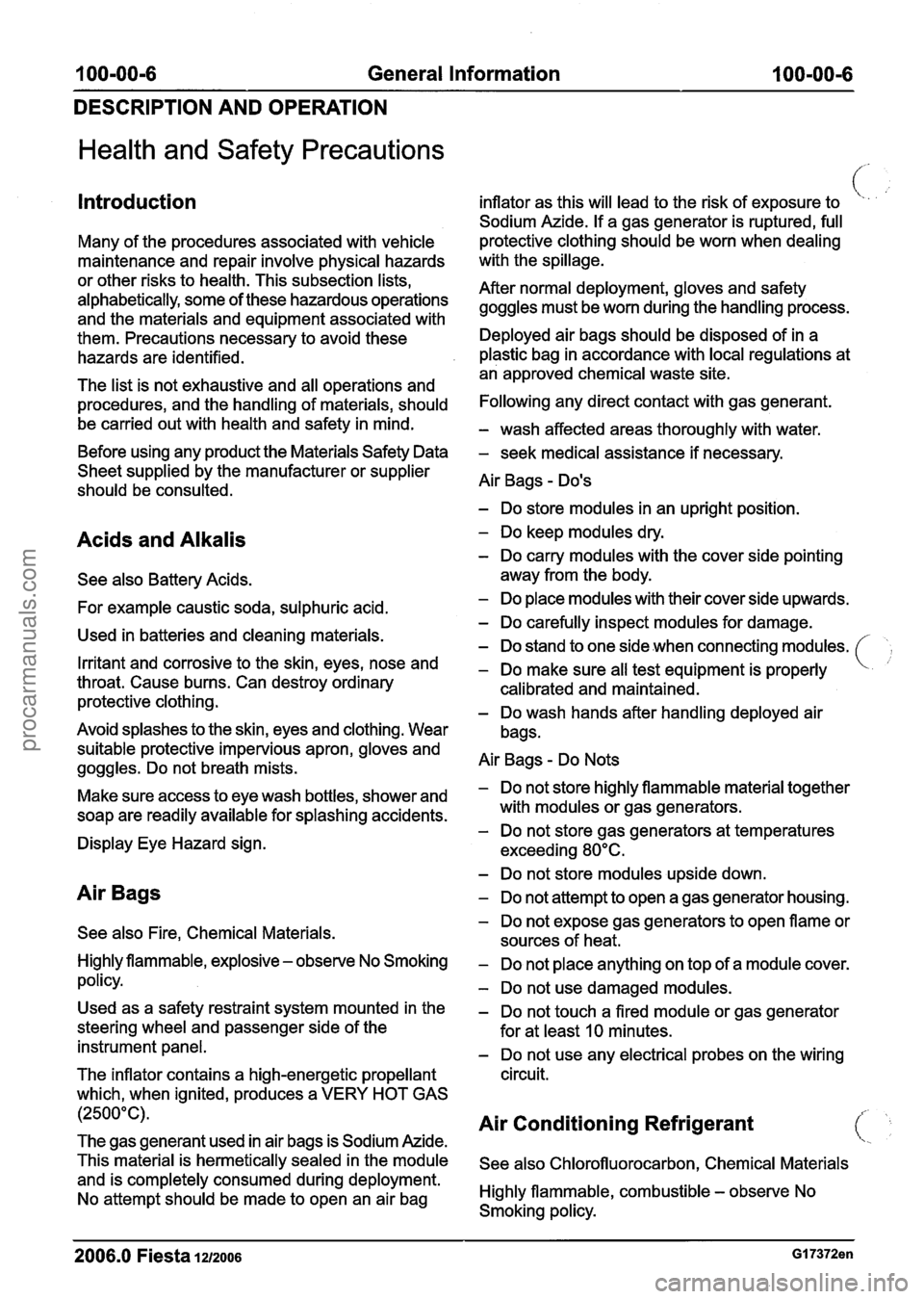
100-00-6 General Information 100-00-6
DESCRIPTION AND OPERATION
Health and Safety Precautions
Introduction
Many of the procedures associated with vehicle
maintenance and repair involve physical hazards
or other risks to health. This subsection lists,
alphabetically, some of these hazardous operations
and the materials and equipment associated with
them. Precautions necessary to avoid these
hazards are identified.
The list is not exhaustive and all operations and
procedures, and the handling of materials, should
be carried out with health and safety in mind.
Before using any product the Materials Safety Data
Sheet supplied by the manufacturer or supplier
should be consulted.
Acids and Alkalis
See also Battery Acids.
For example caustic soda, sulphuric acid.
Used in batteries and cleaning materials.
Irritant and corrosive to the skin, eyes, nose and
throat. Cause burns. Can destroy ordinary
protective clothing.
Avoid splashes to the skin, eyes and clothing. Wear
suitable protective impervious apron, gloves and
goggles. Do not breath mists.
Make sure access to eye wash bottles, shower and
soap are readily available for splashing accidents.
Display Eye Hazard sign.
Air Bags
See also Fire, Chemical Materials.
Highly flammable, explosive
- observe No Smoking
policy.
Used as a safety restraint system mounted in the
steering wheel and passenger side of the instrument panel.
The inflator contains a high-energetic propellant
which, when ignited, produces a VERY HOT GAS
(2500°C).
The gas
generant used in air bags is Sodium Azide.
This material is hermetically sealed in the module
and is completely consumed during deployment.
No attempt should be made to open an air bag inflator
as this will lead to the risk of exposure to
( '.
Sodium Azide. If a gas generator is ruptured, full
protective clothing should be worn when dealing
with the spillage.
After normal deployment, gloves and safety goggles must be worn during the handling process.
Deployed air bags should be disposed of in a
plastic bag in accordance with local regulations at
an approved chemical waste site.
Following any direct contact with gas generant.
- wash affected areas thoroughly with water.
- seek medical assistance if necessary.
Air Bags
- Do's
- Do store modules in an upright position.
- Do keep modules dry.
- Do carry modules with the cover side pointing
away from the body.
- Do place modules with their cover side upwards.
- Do carefully inspect modules for damage.
- Do stand to one side when connecting modules.
- Do make sure all test equipment is properly
calibrated and maintained.
- Do wash hands after handling deployed air
bags.
Air Bags
- Do Nots
- Do not store highly flammable material together
with modules or gas generators.
- Do not store gas generators at temperatures
exceeding 80°C.
- Do not store modules upside down.
- Do not attempt to open a gas generator housing.
- Do not expose gas generators to open flame or
sources of heat.
- Do not place anything on top of a module cover.
- Do not use damaged modules.
- Do not touch a fired module or gas generator
for at least
10 minutes.
- Do not use any electrical probes on the wiring
circuit.
Air Conditioning Refrigerant (1,
See also Chlorofluorocarbon, Chemical Materials
Highly flammable, combustible
- observe No
Smoking policy.
2006.0 Fiesta iu200s GI 7372en
procarmanuals.com
Page 23 of 1226

100-00-7 General Information 100-00-7
DESCRIPTION AND OPERATION
Skin contact may result in frostbite.
Instructions given by the manufacturer must be
followed. Avoid naked lights, wear suitable
protective gloves and goggles.
If refrigerant comes into contact with the skin or
eyes, immediately rinse the affected areas with
water. Eyes should also be rinsed with an
appropriate irrigation solution and should not be
rubbed. SEEK MEDICAL ASSISTANCE IF
NECESSARY.
Air Conditioning Refrigerant - Do Nots
- Do not expose refrigerant bottles to sunlight or
heat.
- Do not stand refrigerant bottles upright; when
filling, hold them with the valve downwards.
- Do not expose refrigerant bottles to frost.
- Do not drop refrigerant bottles.
- Do not vent refrigerant to atmosphere under any
circumstance.
- Do not mix refrigerants, for example R12 (Freon)
and
R134a.
Adhesives and Sealers
See also Fire, Chemical Materials.
Highly flammable, flammable, combustible
-
observe No Smoking policy.
Generally should be stored in No Smoking areas.
Cleanliness and tidiness in use should be
observed, for example disposable paper covering
benches; should be dispensed from applicators
where possible; containers, including secondary
containers, should be labeled appropriately.
Solvent-based AdhesivesISealers - See
Solvents
Follow manufacturers instructions.
Water-based Ad hesives1Sealers
Hot Melt Adhesives
In the solid state, they are safe. In the molten state
they may cause burns and health hazards may
arise from the inhalation of toxic fumes.
Use appropriate protective clothing and a
thermostatically controlled heater with a thermal
cut-out and adequate extraction.
Resin-based AdhesiveslSealers, for
example Epoxide and Formaldehyde
Resin-based
Mixing should be carried out in well ventilated
areas, as harmful or toxic volatile chemicals may
be released.
Skin contact with uncured resins and hardeners
can result in irritation, dermatitis, and absorption
of toxic or harmful chemicals through the skin.
Splashes can damage the eyes.
Provide adequate ventilation and avoid skin and
eye contact.
Anaerobic, Cyanoacrylate (super-glues)
and other Acrylic Adhesives
Many are irritant, sensitizing or harmful to the skin
and respiratory tract. Some are eye irritants.
Skin and eye contact should be avoided and the
manufacturers instructions followed.
Cyanoacrylate adhesives (super-glues) MUST NOT
contact the skin or eyes. If skin or eye tissue is
bonded, cover with a clean moist pad and SEEK
IMMEDIATE MEDICAL ATTENTION. Do not
attempt to pull tissue apart. Use in well ventilated
areas as vapors can cause irritation to the nose
and eyes.
For two-pack systems see Resin-based and
lsocyanate
AdhesivesISealers.
lsocyanate (Polyurethane)
Ad
hesives1Sealers
See also Resin-based Adhesives.
Those based On polymer emulsions and rubber Individuals suffering from asthma or respiratory
latexes may contain small amounts of volatile toxic
allergies should not work with or near these and harmful chemicals. Skin and eye contact
should be avoided and adequate ventilation materials
as sensitivity reactions can occur.
provided during use. Over
exposure is irritating to the eyes and
respiratory system. Excessive concentrations may
produce effects on the nervous system including
2006.0 Fiesta 1212006 GI 7372en
procarmanuals.com
Page 24 of 1226
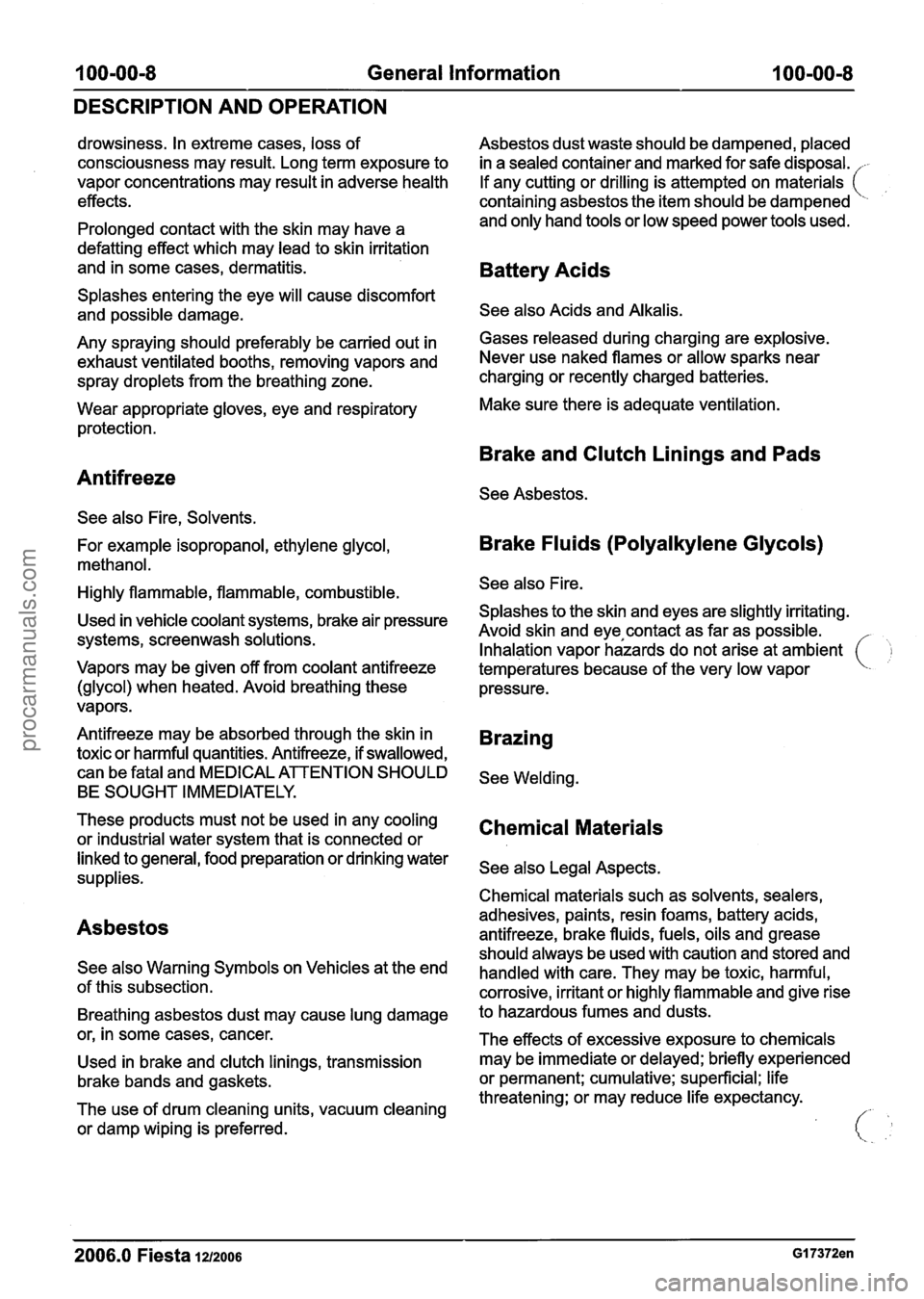
100=00=8 General Information 100=00=8
DESCRIPTION AND OPERATION
drowsiness. In extreme cases, loss of
consciousness may result. Long term exposure to
vapor concentrations may result in adverse health
effects.
Prolonged contact with the skin may have a
defatting effect which may lead to skin irritation
and in some cases, dermatitis.
Splashes entering the eye will cause discomfort
and possible damage.
Any spraying should preferably be carried out in
exhaust ventilated booths, removing vapors and
spray droplets from the breathing zone.
Wear appropriate gloves, eye and respiratory
protection. Asbestos dust
waste should be dampened, placed
in a sealed container and marked for safe disposal.
If any cutting or drilling is attempted on materials
(
containing asbestos the item should be dampened "
and only hand tools or low speed power tools used.
Battery Acids
See also Acids and Alkalis.
Gases released during charging are explosive.
Never use naked flames or allow sparks near
charging or recently charged batteries.
Make sure there is adequate ventilation.
Brake and Clutch Linings and Pads
Antifreeze
See Asbestos.
See also Fire, Solvents.
For example isopropanol, ethylene glycol,
methanol.
Highly flammable, flammable, combustible.
Used in vehicle coolant systems, brake air pressure
systems, screenwash solutions.
Vapors may be given off from coolant antifreeze
(glycol) when heated. Avoid breathing these
vapors.
Antifreeze may be absorbed through the skin in
toxic or harmful quantities. Antifreeze, if swallowed,
can be fatal and MEDICAL ATTENTION SHOULD
BE SOUGHT IMMEDIATELY.
These products must not be used in any cooling
or industrial water system that is connected or
linked to general, food preparation or drinking water
supplies.
Asbestos
See also Warning Symbols on Vehicles at the end
of this subsection.
Breathing asbestos dust may cause lung damage
or, in some cases, cancer.
Used in brake and clutch linings, transmission
brake bands and gaskets.
The use of drum cleaning units, vacuum cleaning
or damp wiping is preferred.
Brake Fluids (Polyal kylene Glycols)
See also Fire.
Splashes to the skin and eyes are slightly irritating.
Avoid skin and
eye'contact as far as possible.
Inhalation vapor hazards do not arise at ambient
temperatures because of the very low vapor
pressure.
Brazing
See Welding.
Chemical Materials
See also Legal Aspects.
Chemical materials such as solvents, sealers,
adhesives, paints, resin foams, battery acids,
antifreeze, brake fluids, fuels, oils and grease
should always be used with caution and stored and
handled with care. They may be toxic, harmful,
corrosive, irritant or highly flammable and give rise
to hazardous fumes and dusts.
The effects of excessive exposure to chemicals may be immediate or delayed; briefly experienced
or permanent; cumulative; superficial; life
threatening; or may reduce life expectancy.
2006.0 Fiesta 1212006 GI 7372en
procarmanuals.com
Page 25 of 1226
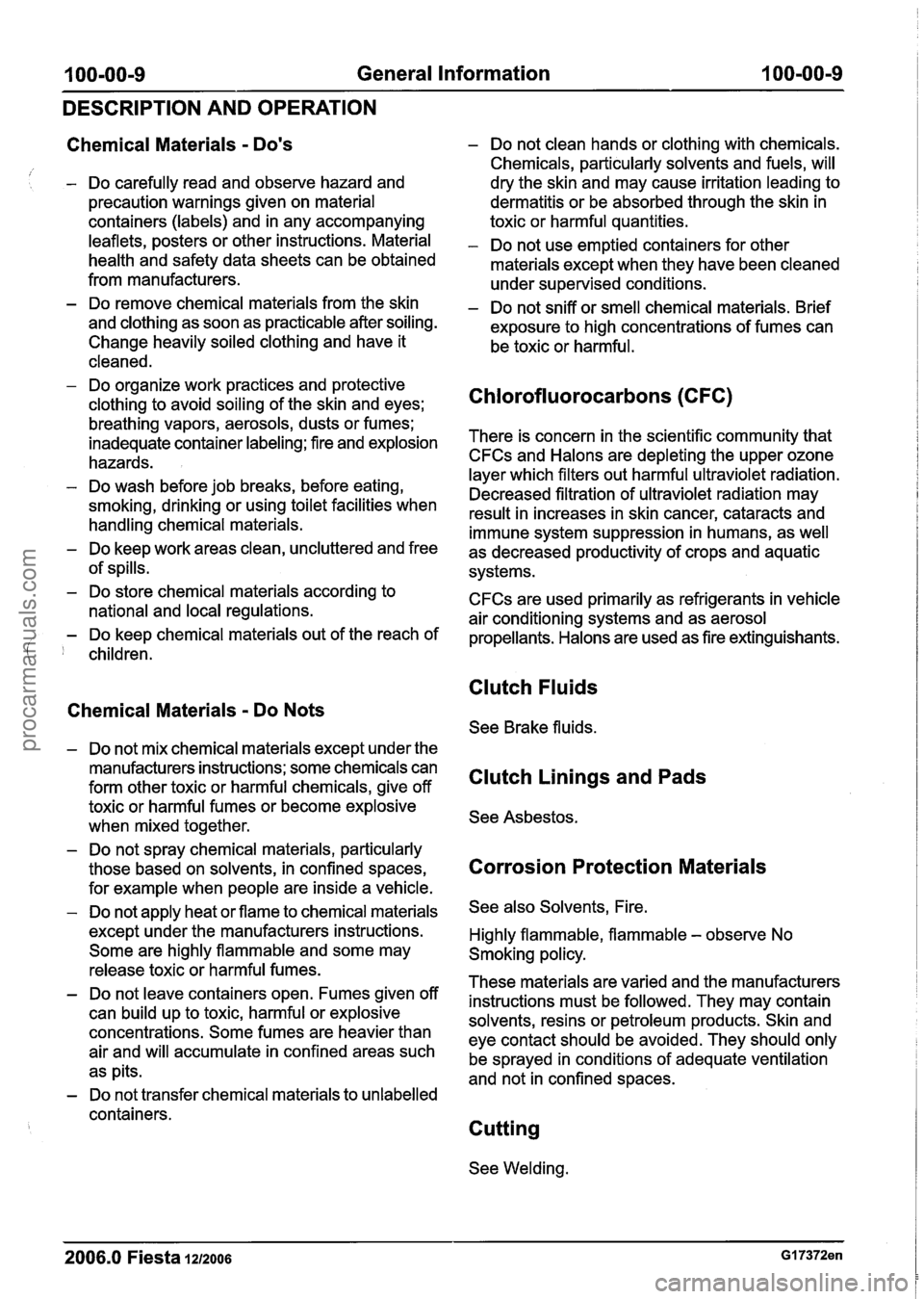
100-00-9 General Information 100-00-9
DESCRIPTION AND OPERATION
Chemical Materials - Do's
/ I - Do carefully read and observe hazard and
precaution warnings given on material
containers (labels) and in any accompanying
leaflets, posters or other instructions. Material
health and safety data sheets can be obtained
from manufacturers.
- Do remove chemical materials from the skin
and clothing as soon as practicable after soiling.
Change heavily soiled clothing and have it
cleaned.
- Do organize work practices and protective
clothing to avoid soiling of the skin and eyes;
breathing vapors, aerosols, dusts or fumes;
inadequate container labeling; fire and explosion
hazards.
- Do wash before job breaks, before eating,
smoking, drinking or using toilet facilities when
handling chemical materials.
- Do keep work areas clean, uncluttered and free
of spills.
- Do store chemical materials according to
national and local regulations.
- Do keep chemical materials out of the reach of
( ' children.
- Do not clean hands or clothing with chemicals.
Chemicals, particularly solvents and fuels, will
dry the skin and may cause irritation leading to
dermatitis or be absorbed through the skin in
toxic or harmful quantities.
- Do not use emptied containers for other
materials except when they have been cleaned
under supervised conditions.
- Do not sniff or smell chemical materials. Brief
exposure to high concentrations of fumes can
be toxic or harmful.
Chlorofluorocarbons (CFC)
There is concern in the scientific community that
CFCs and Halons are depleting the upper ozone
layer which filters out harmful ultraviolet radiation.
Decreased filtration of ultraviolet radiation may
result in increases in skin cancer, cataracts and
immune system suppression in humans, as well
as decreased productivity of crops and aquatic
systems.
CFCs are used primarily as refrigerants in vehicle
air conditioning systems and as aerosol
propellants. Halons are used as fire extinguishants.
Clutch Fluids
Chemical Materials - Do Nots
See Brake fluids.
- Do not mix chemical materials except under the
manufacturers instructions; some chemicals can
form other toxic or harmful chemicals, give off
toxic or harmful fumes or become explosive
when mixed together.
- Do not spray chemical materials, particularly
those based on solvents, in confined spaces,
for example when people are inside a vehicle.
- Do not apply heat or flame to chemical materials
except under the manufacturers instructions. Some are highly flammable and some may
release toxic or harmful fumes.
- Do not leave containers open. Fumes given off
can build up to toxic, harmful or explosive
concentrations. Some fumes are heavier than
air and will accumulate in confined areas such
as pits.
- Do not transfer chemical materials to unlabelled
containers.
Clutch Linings and Pads
See Asbestos.
Corrosion Protection Materials
See also Solvents, Fire.
Highly flammable, flammable
- observe No
Smoking policy.
These materials are varied and the manufacturers instructions must be followed. They may contain
solvents, resins or petroleum products. Skin and
eye contact should be avoided. They should only be sprayed in conditions of adequate ventilation
and not in confined spaces.
Cutting
See Welding.
2006.0 Fiesta 1212006 GI 7372en
procarmanuals.com
Page 26 of 1226
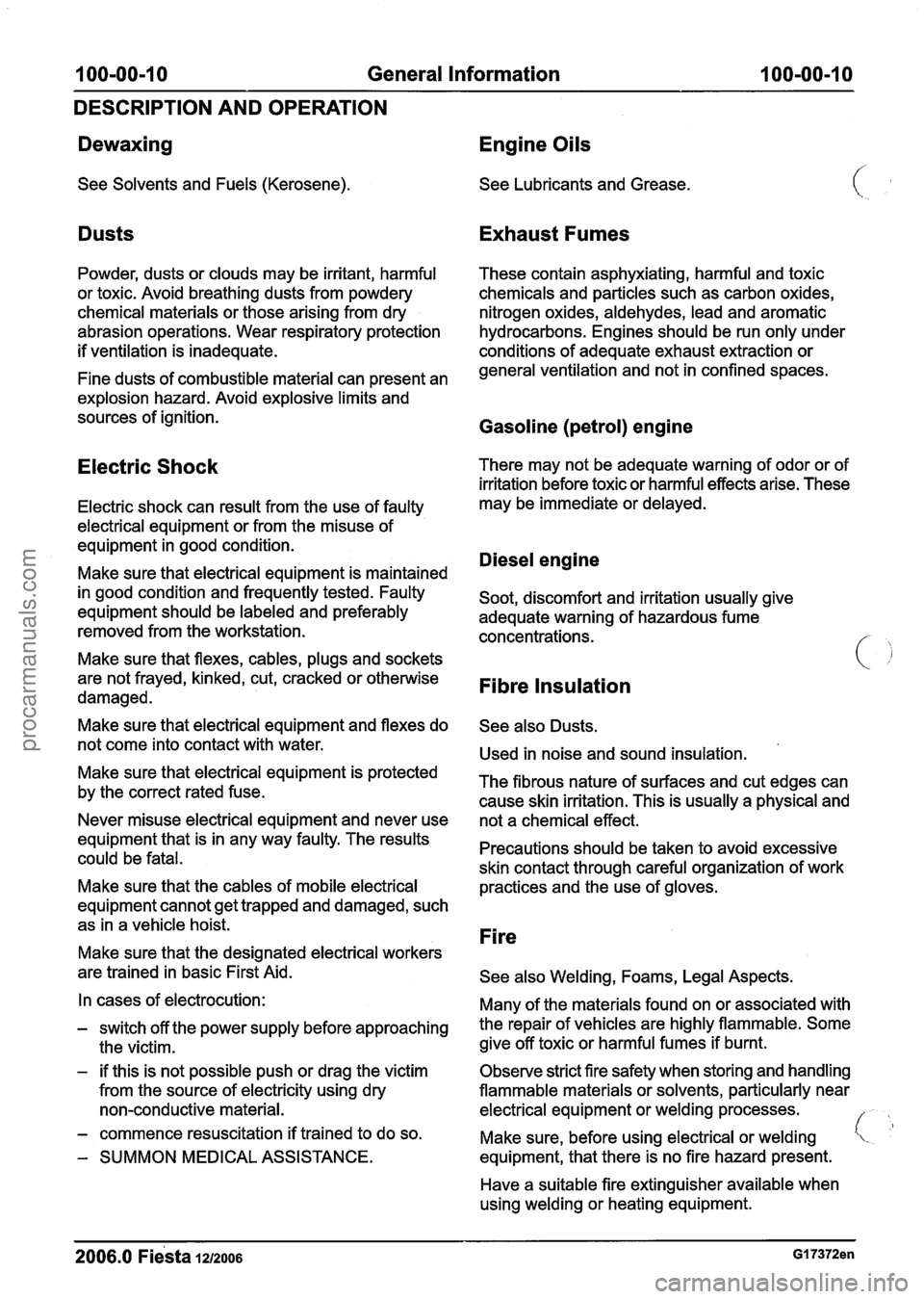
1 OO=OO-10 General Information 100-00-1 0
DESCRIPTION AND OPERATION
Dewaxing Engine Oils
See Solvents and Fuels (Kerosene). See Lubricants and Grease.
Dusts Exhaust Fumes
Powder, dusts or clouds may be irritant, harmful These contain asphyxiating, harmful and toxic
or toxic. Avoid breathing dusts from powdery chemicals and particles such as carbon oxides,
chemical materials or those arising from dry nitrogen oxides, aldehydes, lead and aromatic
abrasion operations. Wear respiratory protection hydrocarbons. Engines should be run only under
if ventilation is inadequate. conditions of adequate exhaust extraction or
Fine dusts of combustible material can present an general ventilation
and not in confined spaces.
explosion hazard. Avoid explosive limits and
sources of ignition.
Gasoline (petrol) engine
Electric Shock There may not be adequate warning of odor or of
irritation before toxic or harmful effects arise. These
Electric shock can result from the use of faulty may be immediate
or delayed.
electrical equipment or from the misuse of
equipment in good condition.
Diesel engine Make sure that electrical equipment is maintained
in good condition and frequently tested. Faulty
Soot, discomfort and irritation usually give
equipment should be labeled and preferably
adequate warning of hazardous fume
removed from the workstation. concentrations.
Make sure that flexes, cables, plugs and sockets
are not frayed, kinked, cut, cracked or otherwise
Fibre damaged.
Make sure that electrical equipment and flexes do
See also Dusts.
not come into contact with water.
Used in noise and sound insulation.
Make sure that electrical is protected The fibrous nature of surfaces and cut edges can by the correct rated fuse.
cause skin irritation. This is usually a physical and
Never misuse electrical equipment and never use
not a chemical effect.
equipment that is in any way faulty. The results
could be fatal. Precautions should
be taken to avoid excessive
skin contact through careful organization of work
Make sure that the cables of mobile electrical
practices and the
;se of gloves.
equipment cannot get trapped and damaged, such
as in a vehicle hoist.
-. Fire Make sure that the designated electrical workers
are trained in basic First Aid.
See also Welding, Foams, Legal Aspects.
In cases of electrocution:
Many of the materials found on or associated with
- switch off the power supply before approaching the repair of vehicles are highly flammable. Some
the victim. give
off toxic or harmful fumes if burnt.
- if this is not possible push or drag the victim
Observe strict fire safety when storing and handling
from the source of electricity using dry flammable materials
or solvents, particularly near
non-conductive material. electrical equipment or welding processes.
/
- commence resuscitation if trained to do so.
Make sure, before using electrical or welding 'L '
- SUMMON MEDICAL ASSISTANCE. equipment,
that there is no fire hazard present.
Have a suitable fire extinguisher available when
using welding or heating equipment.
procarmanuals.com
Page 27 of 1226
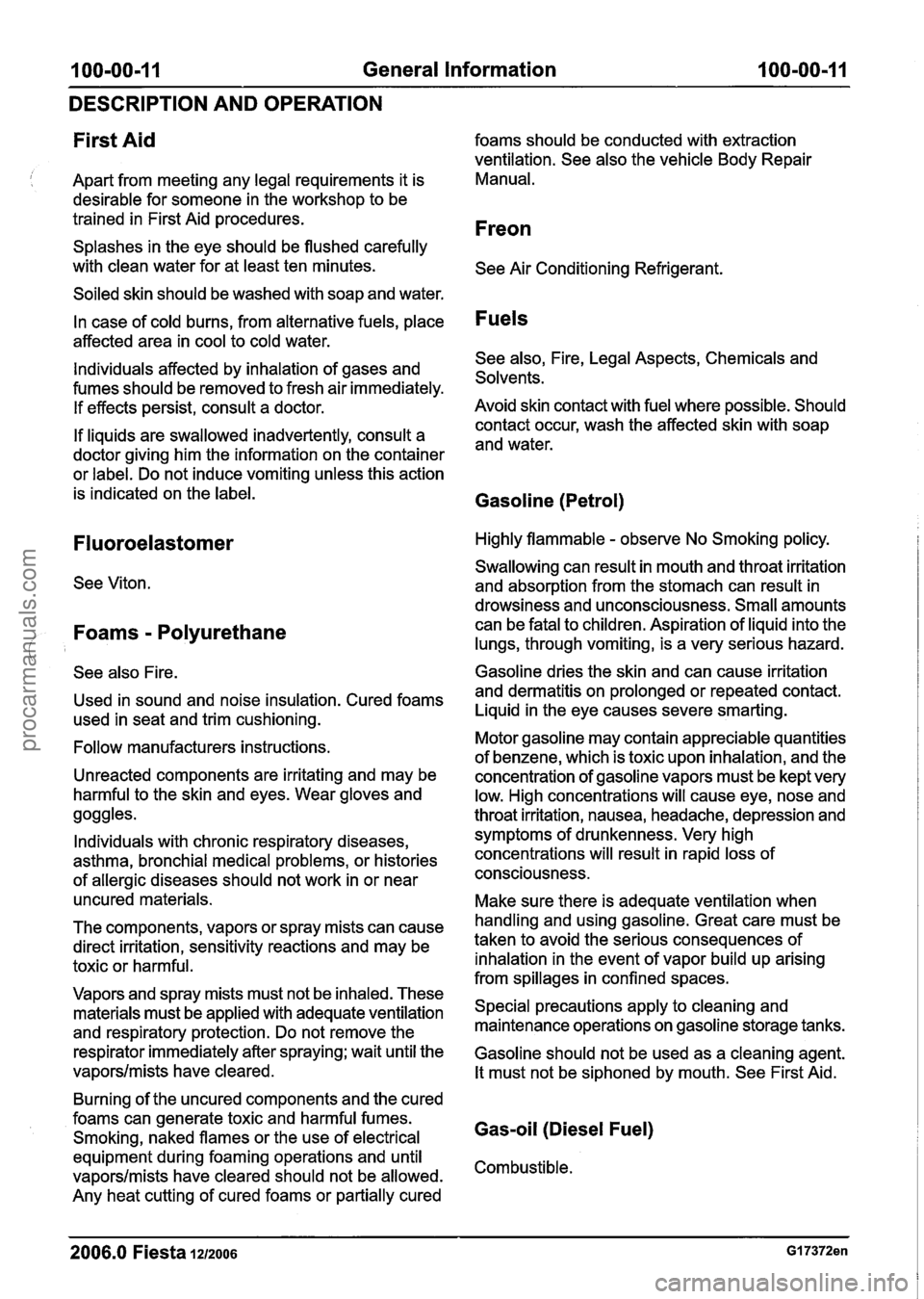
100-00-1 1 General Information 100-00-1 1
DESCRIPTION AND OPERATION
First Aid
Apart from meeting any legal requirements it is
desirable for someone in the workshop to be
trained in First Aid procedures.
Splashes in the eye should be flushed carefully
with clean water for at least ten minutes.
Soiled skin should be washed with soap and water.
In case of cold burns, from alternative fuels, place
affected area in cool to cold water.
Individuals affected by inhalation of gases and
fumes should be removed to fresh air immediately.
If effects persist, consult a doctor.
If liquids are swallowed inadvertently, consult a
doctor giving him the information on the container
or label. Do not induce vomiting unless this action
is indicated on the label.
Fluoroelastomer
See Viton.
Foams - Polyurethane
See also Fire.
Used in sound and noise insulation. Cured foams
used in seat and trim cushioning.
Follow manufacturers instructions.
Unreacted components are irritating and may be
harmful to the skin and eyes. Wear gloves and
goggles.
Individuals with chronic respiratory diseases,
asthma, bronchial medical problems, or histories
of allergic diseases should not work in or near
uncured materials.
The components, vapors or spray mists can cause
direct irritation, sensitivity reactions and may be
toxic or harmful.
Vapors and spray mists must not be inhaled. These
materials must be applied with adequate ventilation
and respiratory protection. Do not remove the
respirator immediately after spraying; wait until the
vapors/mists have cleared.
Burning of the uncured components and the cured
foams can generate toxic and harmful fumes.
Smoking, naked flames or the use of electrical
equipment during foaming operations and until
vapors/mists have cleared should not be allowed.
Any heat cutting of cured foams or partially cured foams
should be conducted with extraction
ventilation. See also the vehicle Body Repair
Manual.
Freon
See Air Conditioning Refrigerant.
Fuels
See also, Fire, Legal Aspects, Chemicals and
Solvents.
Avoid skin contact with fuel where possible. Should
contact occur, wash the affected skin with soap
and water.
Gasoline (Petrol)
Highly flammable - observe No Smoking policy.
Swallowing can result in mouth and throat irritation
and absorption from the stomach can result in
drowsiness and unconsciousness. Small amounts
can be fatal to children. Aspiration of liquid into the
lungs, through vomiting, is a very serious hazard.
Gasoline dries the skin and can cause irritation
and dermatitis on prolonged or repeated contact.
Liquid in the eye causes severe smarting.
Motor gasoline may contain appreciable quantities
of benzene, which is toxic upon inhalation, and the
concentration of gasoline vapors must be kept very
low. High concentrations will cause eye, nose and
throat irritation, nausea, headache, depression and
symptoms of drunkenness. Very high
concentrations will result in rapid loss of
CO~SC~OUS~~SS.
Make sure there is adequate ventilation when
handling and using gasoline. Great care must be
taken to avoid the serious consequences of
inhalation in the event of vapor build up arising
from spillages in confined spaces.
Special precautions apply to cleaning and
maintenance operations on gasoline storage tanks.
Gasoline should not be used as a cleaning agent.
It must not be siphoned by mouth. See First Aid.
Gasoil (Diesel Fuel)
Com busti ble.
2006.0 Fiesta 1212006 GI 7372en
procarmanuals.com
Page 28 of 1226
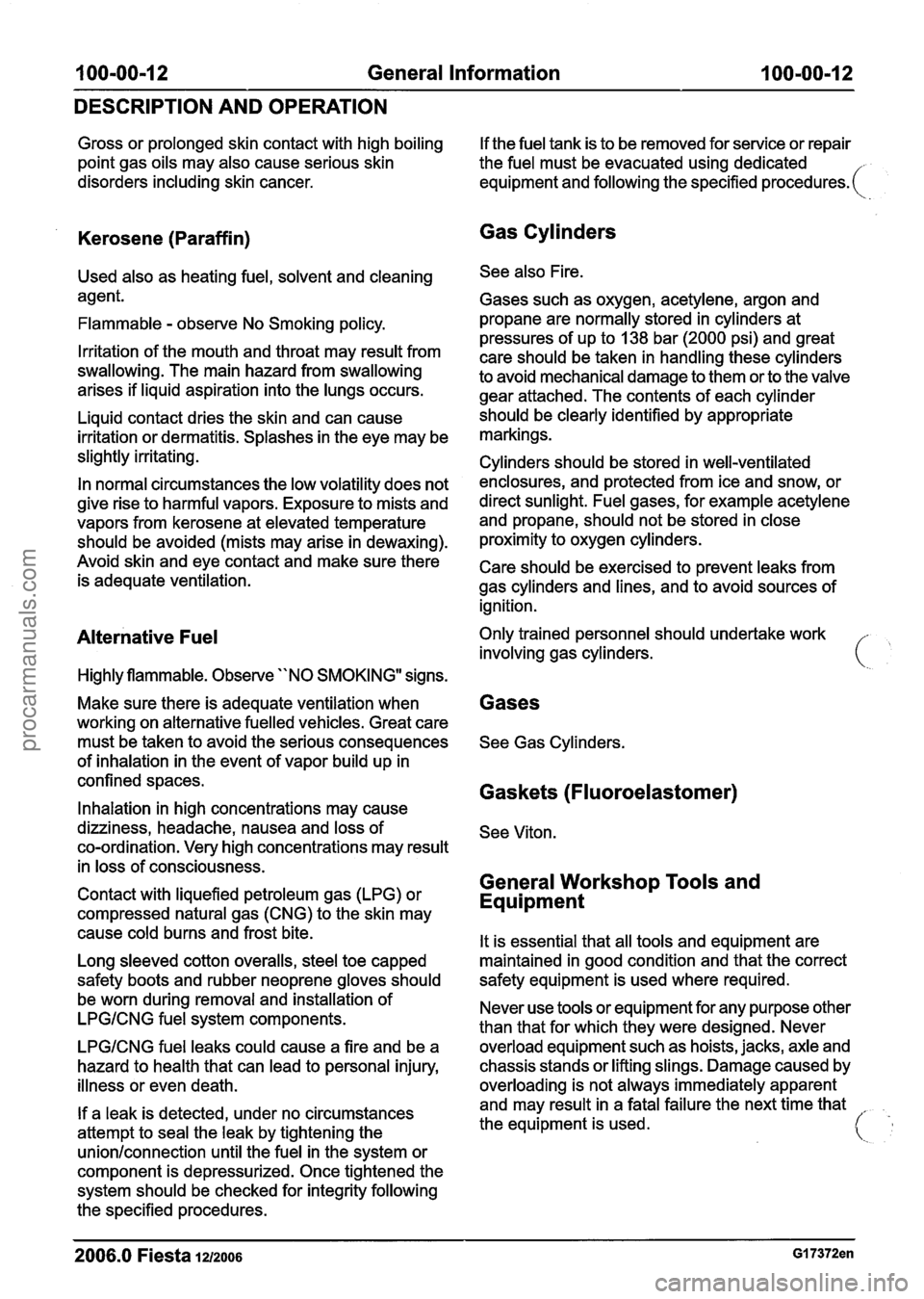
100-00-12 General Information 100-00-12
DESCRIPTION AND OPERATION
Gross or prolonged skin contact with high boiling
point gas oils may also cause serious skin
disorders including skin cancer.
Kerosene (Paraffin)
Used also as heating fuel, solvent and cleaning
agent.
Flammable
- observe No Smoking policy.
Irritation of the mouth and throat may result from
swallowing. The main hazard from swallowing
arises if liquid aspiration into the lungs occurs.
Liquid contact dries the skin and can cause
irritation or dermatitis. Splashes in the eye may be
slightly irritating.
In normal circumstances the low volatility does not
give rise to harmful vapors. Exposure to mists and
vapors from kerosene at elevated temperature
should be avoided (mists may arise in dewaxing).
Avoid skin and eye contact and make sure there
is adequate ventilation.
Alternative Fuel
Highly flammable. Observe "NO SMOKING" signs.
Make sure there is adequate ventilation when
working on alternative fuelled vehicles. Great care
must be taken to avoid the serious consequences
of inhalation in the event of vapor build up in
confined spaces.
Inhalation in high concentrations may cause
dizziness, headache, nausea and loss of
co-ordination. Very high concentrations may result
in loss of consciousness.
Contact with liquefied petroleum gas (LPG) or
compressed natural gas (CNG) to the skin may
cause cold burns and frost bite.
Long sleeved cotton overalls, steel toe capped
safety boots and rubber neoprene gloves should
be worn during removal and installation of
LPGICNG fuel system components.
LPGICNG fuel leaks could cause a fire and be a
hazard to health that can lead to personal injury,
illness or even death.
If a leak is detected, under no circumstances
attempt to seal the leak by tightening the
unionlconnection until the fuel in the system or
component is depressurized. Once tightened the
system should be checked for integrity following
the specified procedures. If
the fuel tank is to be removed for service or repair
the fuel must be evacuated using dedicated
equipment and following the specified
procedures. (
Gas Cylinders
See also Fire.
Gases such as oxygen, acetylene, argon and
propane are normally stored in cylinders at
pressures of up to
138 bar (2000 psi) and great
care should be taken in handling these cylinders
to avoid mechanical damage to them or to the valve
gear attached. The contents of each cylinder
should be clearly identified by appropriate
markings.
Cylinders should be stored in well-ventilated
enclosures, and protected from ice and snow, or
direct sunlight. Fuel gases, for example acetylene
and propane, should not be stored in close
proximity to oxygen cylinders.
Care should be exercised to prevent leaks from
gas cylinders and lines, and to avoid sources of
ignition.
Only trained personnel should undertake work
involving gas cylinders.
Gases
See Gas Cylinders.
Gaskets (Fluoroelastomer)
See Viton.
General Workshop Tools and
Equipment
It is essential that all tools and equipment are
maintained in good condition and that the correct
safety equipment is used where required.
Never use tools or equipment for any purpose other
than that for which they were designed. Never
overload equipment such as hoists, jacks, axle and
chassis stands or
lifting slings. Damage caused by
overloading is not always immediately apparent
and may result in a fatal failure the next time that
the equipment is used.
2006.0 Fiesta 1212006 GI 7372en
procarmanuals.com
Page 29 of 1226
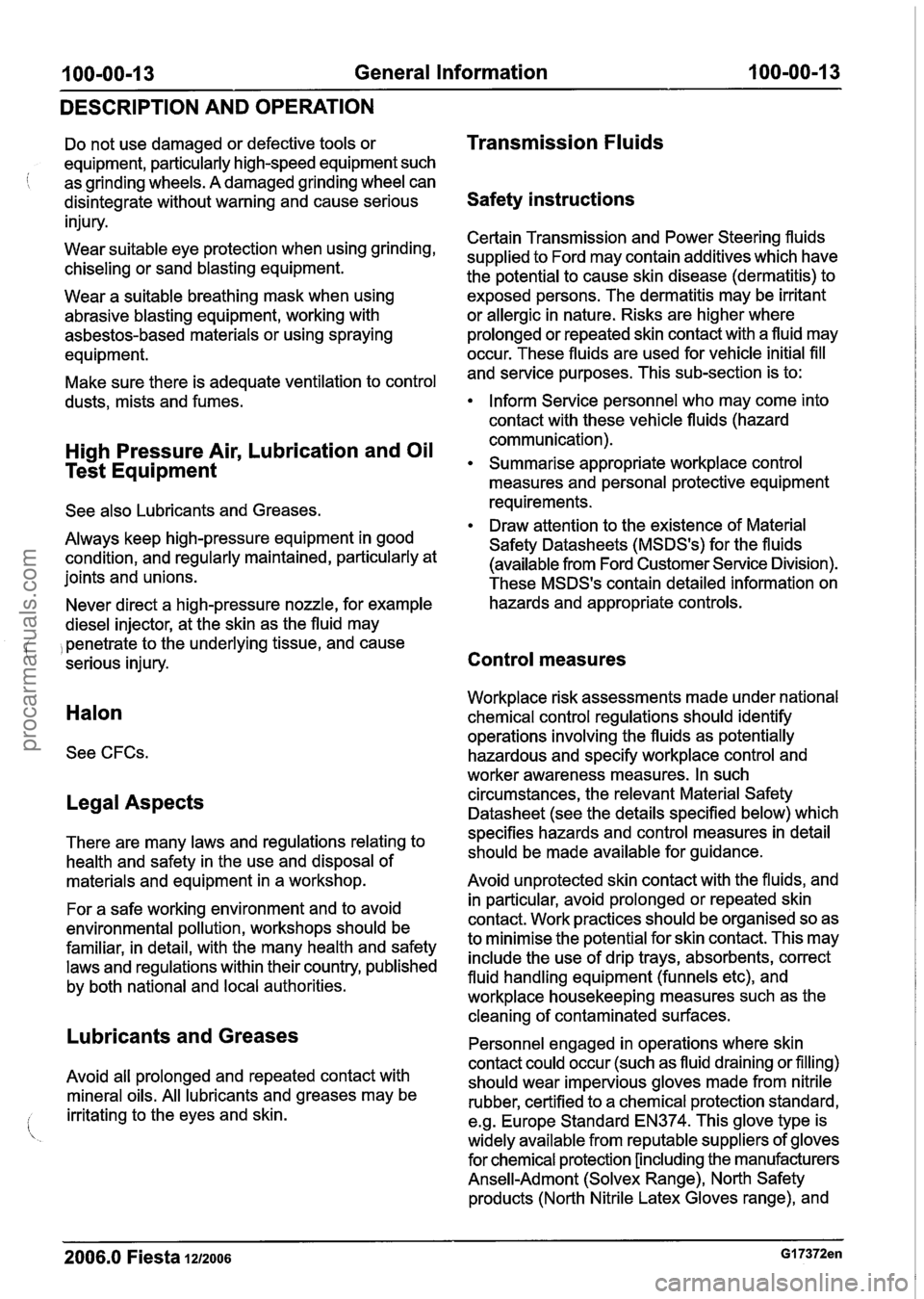
100-00-1 3 General Information 100-00-1 3
DESCRIPTION AND OPERATION
Do not use damaged or defective tools or
equipment, particularly high-speed equipment such
i as grinding wheels. A damaged grinding wheel can
disintegrate without warning and cause serious
injury.
Wear suitable eye protection when using grinding,
chiseling or sand blasting equipment.
Wear a suitable breathing mask when using
abrasive blasting equipment, working with
asbestos-based materials or using spraying
equipment.
Make sure there is adequate ventilation to control
dusts, mists and fumes.
High Pressure Air, Lubrication and Oil
Test Equipment
See also Lubricants and Greases.
Always keep high-pressure equipment in good
condition, and regularly maintained, particularly at
joints and unions.
Never direct a high-pressure nozzle, for example
diesel injector, at the skin as the fluid may
, penetrate to the underlying tissue, and cause
serious injury.
Halon
See CFCs.
Legal Aspects
There are many laws and regulations relating to
health and safety in the use and disposal of
materials and equipment in a workshop.
For a safe working environment and to avoid
environmental pollution, workshops should be
familiar, in detail, with the many health and safety
laws and regulations within their country, published
by both national and local authorities.
Lubricants and Greases
Avoid all prolonged and repeated contact with
mineral oils. All lubricants and greases may be
irritating to the eyes and skin.
'
Transmission Fluids
Safety instructions
Certain Transmission and Power Steering fluids
supplied to Ford may contain additives which have
the potential to cause skin disease (dermatitis) to
exposed persons. The dermatitis may be irritant
or allergic in nature. Risks are higher where
prolonged or repeated skin contact with a fluid may
occur. These fluids are used for vehicle initial
fill
and service purposes. This sub-section is to:
Inform Service personnel who may come into
contact with these vehicle fluids (hazard
communication).
Summarise appropriate workplace control
measures and personal protective equipment
requirements.
Draw attention to the existence of Material
Safety Datasheets (MSDS's) for the fluids
(available from Ford Customer Service Division).
These MSDS's contain detailed information on
hazards and appropriate controls.
Control measures
Workplace risk assessments made under national
chemical control regulations should identify
operations involving the fluids as potentially
hazardous and specify workplace control and
worker awareness measures. In such
circumstances, the relevant Material Safety
Datasheet (see the details specified below) which
specifies hazards and control measures in detail
should be made available for guidance.
Avoid unprotected skin contact with the fluids, and
in particular, avoid prolonged or repeated skin
contact. Work practices should be organised so as
to minimise the potential for skin contact. This may
include the use of drip trays, absorbents, correct
fluid handling equipment (funnels etc), and
workplace housekeeping measures such as the
cleaning of contaminated surfaces.
Personnel engaged in operations where skin
contact could occur (such as fluid draining or filling)
should wear impervious gloves made from
nitrile
rubber, certified to a chemical protection standard,
e.g. Europe Standard EN374. This glove type is
widely available from reputable suppliers of gloves
for chemical protection [including the manufacturers
Ansell-Admont
(Solvex Range), North Safety
products (North
Nitrile Latex Gloves range), and
2006.0 Fiesta 1212006 GI 7372en
procarmanuals.com
Page 30 of 1226
![FORD FIESTA 2007 Owners Manual
100-00-1 4 General Information 100-00-1 4
DESCRIPTION AND OPERATION
Marigold Industrial (Blue Nitrile range)]. If gloves
become torn or contaminated on the inside they
should be replaced. Eye FORD FIESTA 2007 Owners Manual
100-00-1 4 General Information 100-00-1 4
DESCRIPTION AND OPERATION
Marigold Industrial (Blue Nitrile range)]. If gloves
become torn or contaminated on the inside they
should be replaced. Eye](/img/11/56936/w960_56936-29.png)
100-00-1 4 General Information 100-00-1 4
DESCRIPTION AND OPERATION
Marigold Industrial (Blue Nitrile range)]. If gloves
become torn or contaminated on the inside they
should be replaced. Eye protection with safety
glasses is appropriate. Use of an impervious apron
and arm protectors may be necessary if more
extensive exposure is possible. Use of skin barrier
creams suitable for work with mineral oil products
may offer some supplementary protection, but such
barrier creams should not be used in place of
protective clothing.
If accidental skin contact occurs with the fluids,
wash the area thoroughly with soap or skin
cleanser and water.
Accidental eye contact should be dealt with as per
normal first aid practices, by flushing the eyes with
an eye wash or clean cool water for
10 minutes,
after which medical attention should be obtained.
Remove and launder clothing which becomes
contaminated with the fluids. Do not place rags
contaminated with fluid in clothing pockets.
Wash thoroughly
after completing operations where
skin exposure may have occurred.
It is important that personnel do not smoke, eat or
drink whilst handling the fluids or affected
transmissions. These measures are designed to
limit the risk from accidental ingestion.
Label any decanted fluid
properlyluse an equivalent
label to that on original product containers.
Clean up any spills promptly using an inert
absorbent and wash down contaminated surfaces
with detergent and water.
Dispose of any waste fluids safely as hazardous
waste. Do
not employ used engine oils as lubricants or
for any application where appreciable skin contact
is likely to occur.
Environmental Precautions
Burning used engine oil in small space heaters or
boilers can be recommended only for units of
.
approved design. If in doubt check with the
appropriate local authority and manufacturer of
approved appliances.
Dispose of used oil and used oil filters through
authorized waste disposal contractors or licensed
waste disposal sites, or to the waste oil reclamation
trade. If in doubt, contact the relevant local
authority for advice on disposal facilities.
It is illegal to pour used oil on to the ground, down
sewers or drains, or into watercourses.
Noise
Some operations may produce high noise levels,
which could, in time, damage hearing. In these
cases, suitable ear protection must be worn.
Noise Insulation Materials
See Foams, Fibre Insulation.
0-Rings (Fluoroelastomer)
See Viton.
Paints
Safety Data Sheets
See also Solvents, Chemical Materials.
Safety Data Sheets, which detail specific material handling instructions and precautions are available
from the respective national sales company, and
via internet
www.msds.ford .corn.
Used Engine Oil
Prolonged and repeated contact with mineral oil
will result in the removal of natural fats from the
skin, leading to dryness, irritation and dermatitis.
In addition, used engine oil contains potentially
harmful contaminants, which may cause skin
cancer. Adequate means of skin protection and
washing facilities must be provided. Highly flammable, flammable
- observe No
Smoking policy
One Pack
Can contain harmful or toxic pigments, driers and
other components as well as solvents. Spraying
should be carried out only with adequate
ventilation.
2006.0 Fiesta 1212006 GI 7372en
procarmanuals.com